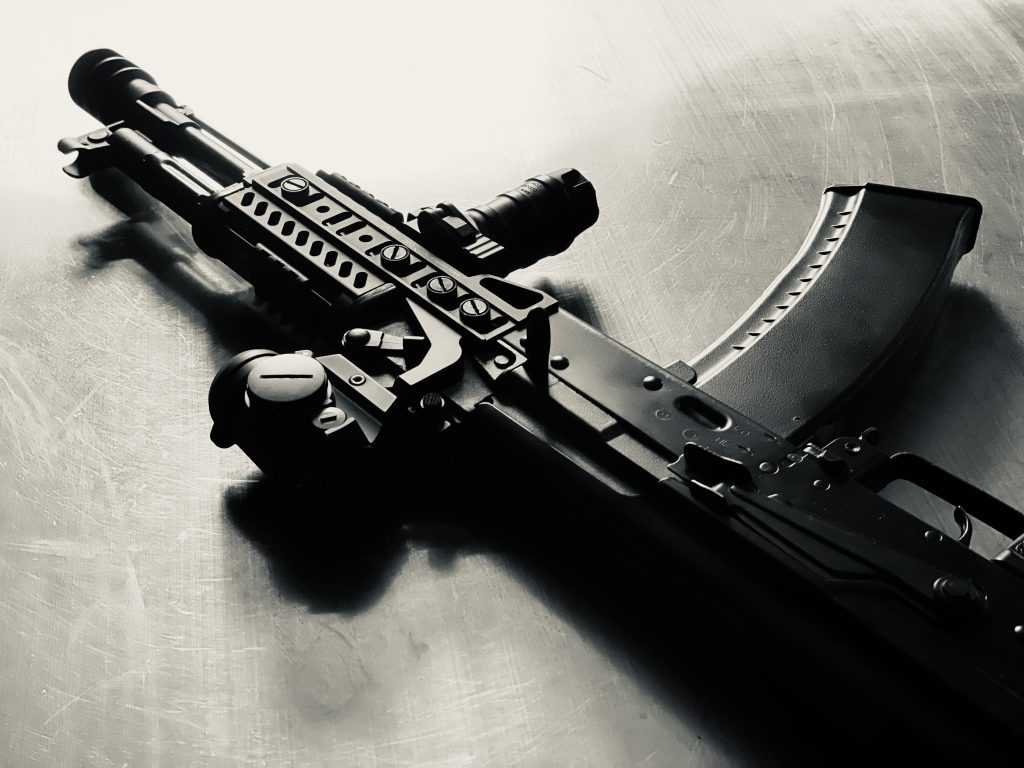
Authors note: this article originally appeared in Airsoft Action Magazine issue #131, December 2021.
Throughout my years playing Airsoft, I have had a long love affair with the AK series AEG rifle. A Real Sword Type 56-1 was the second rifle I purchased after my Tokyo Marui Type 89. After that would follow the standard Type 56, then the 56-2 and well over a dozen variations and brands of AK thereof. I admit I had a brief moment where I felt the temptation from the dark side and dabbled with some M4 style rifles, but now have returned home from my journey to Mordor, having cast most of my M4’s into the fires of Mount Doom and am enjoying the comforts of my beloved AK’s again.
Few Airsoft rifles manage to capture the solidity and break-down-a-door feel of a rifle as the AK series do: 3.34kg of cold stamped steel simply feels unlike anything else out there. The aesthetics and operating controls of an AK are divisive to some, albeit practical in its simple no-frills brutalist design tinged with a flair of the apocalyptic; this is a rifle that would feel at home in the wilds of a Mad Max-esque universe. You could throw it off a cliff or run it over with a truck (and some have) and it would still keep on ticking.
While I have more traditional AK setups in my inventory, my current preference is to enjoy some of the modernized enhancements made for the platform. Owing to that, I’ve selected the (unfortunately named) LCT LCK104 as the foundation for my “dream AK build.”
Background
The AK-100 series rifles were introduced in 1994 by the Izhmash factories in Izhevsk, Russia as a series of modernized rifles intended for both domestic use and export sales. They are most notably recognized by the presence of glass-filled polyamide folding stocks and black handguards which are prominently featured on their most popular models: the AK-105 chambered in 5.45x39mm and using 74 style magazines, followed by its cousin the AK-104, which is chambered in the venerable 7.62x39mm cartridge and using 47 style magazines. Incidentally, this brings us to why the LCT replica is misnamed; owing that it is based off the AK-105 design which sports 5.45x39mm 74 style magazines.
One might consider these rifles somewhat analogous to the M4 carbine in design and purpose, as they are approximate in length and weight and often configured with modern sighting devices, rail systems, white lights and IR lasers and/or illuminators. The AK-105 features a 314mm (12.4 in) long barrel and is 824mm (32.4 in) with stock extended, or 586mm (23.1 in) with stock folded.
Both the AK-105 and the 104 have been seen in extensive use with Russian special forces groups, such as the well known Spetsgruppa “A” and the Special Rapid Response Unit (SOBR) among others. The AK-105 appears to be the most prolific version in evidence, with some much smaller numbers of the 104 version being used for the 7.62x39mm’s favorable anti-barrier characteristics as well as being an excellent cartridge for suppression out of shorter barrels.
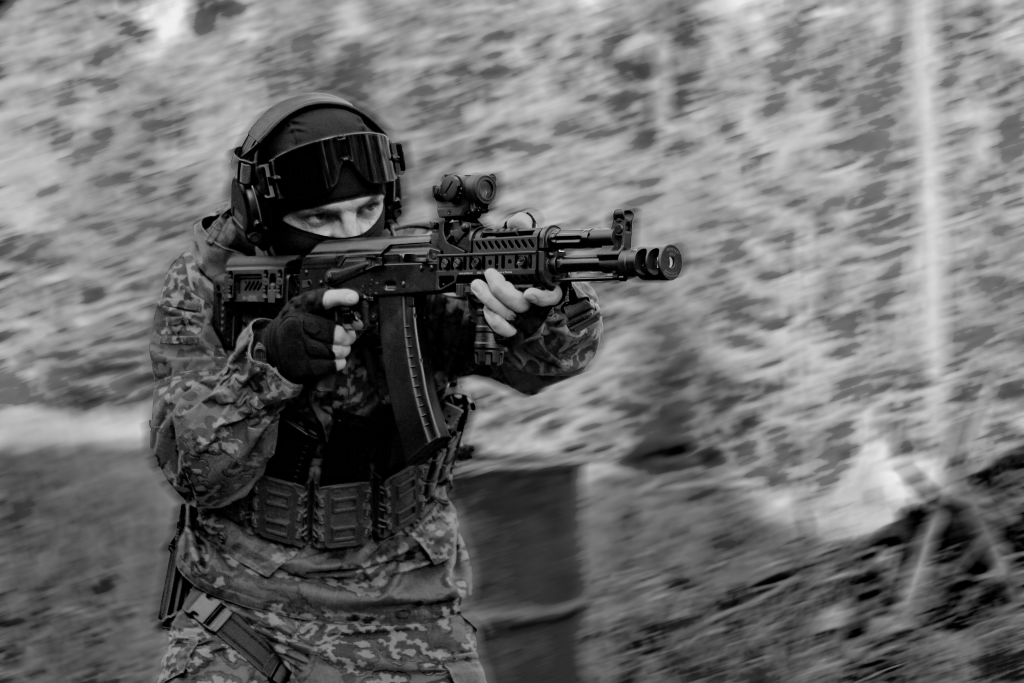
The Build
LCT’s confused nomenclature aside, the AK-105 is a solid beast of a rifle clocking in at 3.34 kg (7.73 lbs) of nicely blued stamped and cast steel fittings, with not a wobble or creak in sight. Purists will note some minor discrepancy with regard to the accuracy of the receiver markings as compared to the real rifle, but this is a minor point of contention and does not affect the function or utility of the gun. Bottom line: if you want a quality built AK-105 series rifle, this is one of the best – if not top – choices out there.
While LCT’s stock internals are honestly pretty decent and the rifle is very skirmishable with out of the box, I generally work under the premise that most guns are simply bodies for me to pour some upgrades and tuning into. Here I have elected to leverage some of the latest Airsoft innovations with the tried and true to fashion my dream AK build.
You will note throughout this build that I use some of the stock LCT components. This is because they are either the best part for the job, or it makes little sense to replace it (the point of diminishing returns). Hence, I have kept the stock gearbox shell; Version 3 shells almost never break. I’ve also kept the stock 9mm bearings as I’ve rarely seen those fail and bearings offer a slight edge in efficiency over bushings. Similarly, the air nozzle, tappet plate, cylinder and hop up chamber are kept stock too. These are all good quality components that work very well and it would just be needlessly burning money replacing them.
The “powerplant” of this gun is based off the relatively new Warhead brushless motor. The version used in this gun is the standard torque, which is listed as running at 30,000 RPM with an 11.1v. In my humble opinion, these are the very best motors available to Airsoft today and the Warhead in particular neatly edges out competitor brushless designs in nearly every aspect.
I’m no stranger to slaving away for ‘efficiency builds’, but honestly the Warheads have shockingly low amp draw. Even with deliberately setting out to build some otherwise stressful builds by previous standards, the amp draw on these motors simply cannot be matched by anything in the traditional Neodymium or much older Ferrite range. Incidentally, this also makes it a prime candidate for rifles that might be constrained by small battery space. Leveraging the low amp draw of the brushless motor means you can safely get away with using smaller batteries without fear of damaging them or exceeding their safety ratings. In the case of this build, I am drawing a mere 10.2 amps in semi-auto and 9 amps in full auto with a peak draw of 27.4 amps, which is well within the comfort zone of the 11.1v 1200mah 25c LiPo’s I am using under the dust cover.
Housing the motor is one of LCT’s replacement CNC motor cages. It’s been my experience that it’s not a matter of “if” the stock motor cage will break, but only “when.” The CNC cages are substantially stronger than the relatively brittle cast material used on the stock cages and are also not as prone to stripping the threads for the grip screw. So in my book, this is simply a good preventative measure to avoid some frustrating occurrences.
For gears, I have elected to stick with the tried and true SHS 13.65:1’s which have been short stroked 3-teeth. Some might argue that a dream build should at least host Siegetek gears, and perhaps rightly so. But this is not a point of cost so much as a point of preference; I simply prefer the auditory sound of SHS’s over Siegetek’s, the latter of which are (due to design) mechanically noisier. The 13.65:1’s are also my current preferred ratio to pair with the Warhead standard torque as it still offers excellent trigger response but still possesses an above-average ROF.
With this combination I’m hitting around 25 RPS with an averaged firing response time of 24 ms (0.024 seconds). To put trigger response into perspective, one can compare it to “lock time” in real firearms. Lock time refers to the time interval from when the trigger is pulled until the firing pin strikes the primer. The speed of lock time varies considerably over the different designs of action. For example, the milspec AR15 and HK416 triggers have a lock time around 10 ms (0.01 seconds).
Naturally this build is also hosting a Gate TITAN Advanced. This is an electronic trigger unit that replaces the mechanical switch, cutoff lever and wiring with a device that uses optical sensors to record sector gear and trigger movement. The TITAN offers a plethora of features, from fire control customization, pre-cocking, active brake, and more. It’s a point of debate as to which is the coolest feature of the TITAN, but my vote is for the adjustable trigger sensitivity. On a stock AEG AK that uses a Ver. 3 gearbox and mechanical trigger switch, the trigger pull is quite long – substantially so even compared to a stock M4 AEG. With the TITAN, the end user can set the firing point at any part of the trigger pull; from practically nothing to all the way to the rear. Ideally one also pairs the TITAN with an adjustable trigger offering an overtravel stop to take full advantage of this feature.
Unlike an M4 AEG, however, there does not really exist an aftermarket trigger for the AK that allows you to set the desired amount of overtravel. Overtravel is defined by the amount of “dead space” after the firing point to where you cannot physically pull the trigger any farther. By eliminating dead space and reducing the length of pull, you can operate the trigger much faster – “flutter” it, if you will. This is especially ideal for users who prefer to shoot primarily in the semi-auto mode.
In order to achieve overtravel adjustment, I’ve modified my stock LCT trigger to have an adjustable set screw. I’ve traditionally always gone with externally adjustable modifications to the wide outer flange of the trigger, but this can be problematic due to gearbox tolerances and lack of supporting material to bump the screw up against. Since I generally do not readjust the length of pull once I hit the desired sweet spot, this time around I’ve modified the inside of the trigger for the set screw. A dab of threadlocker ensures it will not wander out under vibration. The finished result is a trigger pull that measures 6.35mm (1/4 in) from resting to full pull.
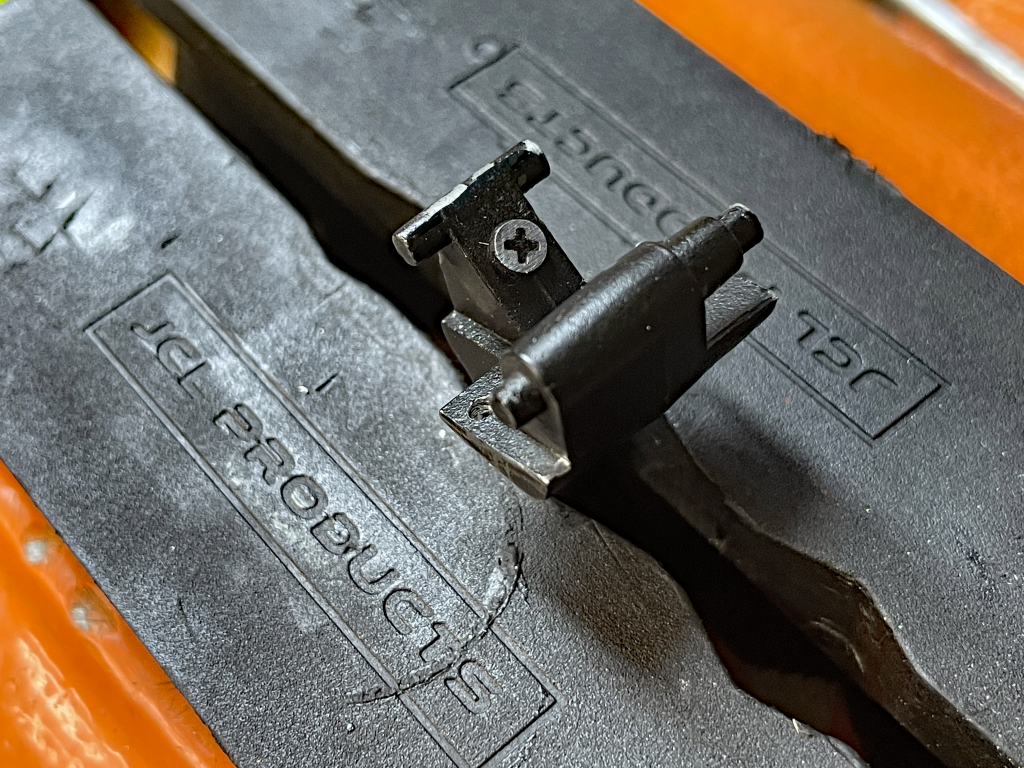
The rest of the gearbox hosts the usual dead-reliable compression upgrades I’ve used for years now. The stock LCT piston has been replaced with the unbeatable CYMA full metal rack piston which has been AOE corrected and the rack epoxied in place. A Lonex ported POM piston head rides on the front, with a 70d hardness AirPad providing shock absorption and assisting in the AOE corrective aspects off the back of the cylinder head. Lastly, the cylinder head itself is a Guarder stainless steel double o-ring version. It was not actually necessary to replace the stock LCT cylinder head as it’s made from aluminum and very durable. But I had the Guarder already prepped with an installed AirPad sitting around looking for a new home, so it wound up in the build out of convenience. So that’s my one concession for “unnecessary parts replaced for no reason.”
A Guarder SP120 spring powers the piston, which delivers just shy of 396 FPS with a very consistent 0.5 – 1 FPS variance between shots. I’ve used Guarder springs in nearly every build for well over a decade plus now and they’ve proven to be extremely durable and long-lived while outputting consistent energy.
As previously mentioned, the air nozzle is the stock LCT nozzle, which has an o-ring and seals well with most buckings. I’ve always found using the stock LCT nozzle works the best and any time you can remove nozzle length issues from the equation and avoid tolerance stacking is a good thing.
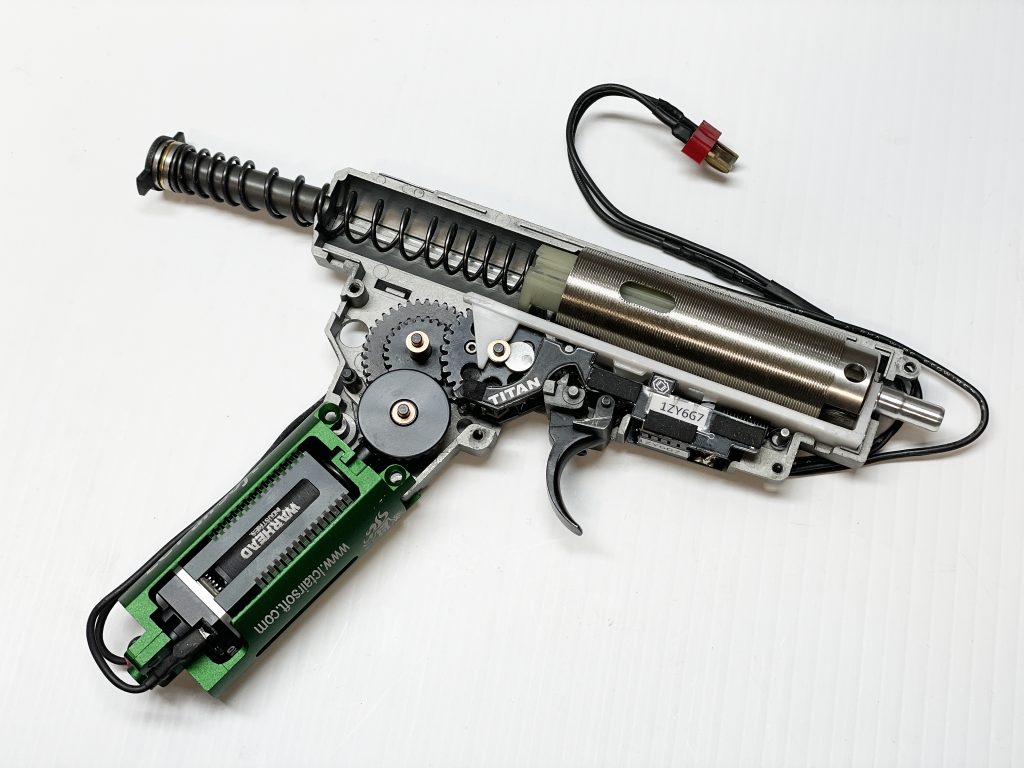
The hop up chamber is also stock LCT. Again, these just plain work and provide trouble free operation unlike many aftermarket chambers I have trialed over the years. AK’s are also intrinsically accurate designs, owing in large part to the design of the hop up chamber and stabilizing method by which it is attached to the outer barrel. Suffice it to say, it’s a very rigid assembly.
Finally, getting to the end of our upgrades – I divert from stock usage of parts by upgrading the inner barrel with a Lambda One 6.01 SUS304 cold forged stainless steel barrel and R-Hop installation. I’ve modified the hop up arm to host an M-Nub, which is a small square of semi-firm material from 3M that provides full length even pressure against the R-Hop contact patch. The bucking used is a black Modify Baton. When coupled with heavyweight BB’s in the nature of .28g to .36g, this allows me to seriously leverage the range and accuracy advantage of this system to my benefit.
External Modifications
Not content with just letting it lie, I’ve also done a number of changes to the external side of the gun. Most notably among these is the addition of the rail system, which is made by TWI and is a replica of the Zenitco B-10U lower handguard with the B-19N top handguard. I opted for the shorter handguard setup as opposed to the more common B-30 style as it only adds 155g (5.5oz) to the weight of the gun. A real Zentico B-22 mount is affixed to the B-10U and is sporting a Holosun HS403R red dot sight. This is a fairly close approximation to an Aimpoint T2 in design footprint, but built with better quality than the usual Airsoft replicas of the T2. It features a crisp 2 MOA dot with 12 brightness settings, with the lowest settings being night vision compatible. Speaking of: one of the reasons I selected the B-22 mount over the more common B-33 railed dust cover is because it puts the red dot up high enough to allow for using night vision over the top of the receiver for passive aiming.
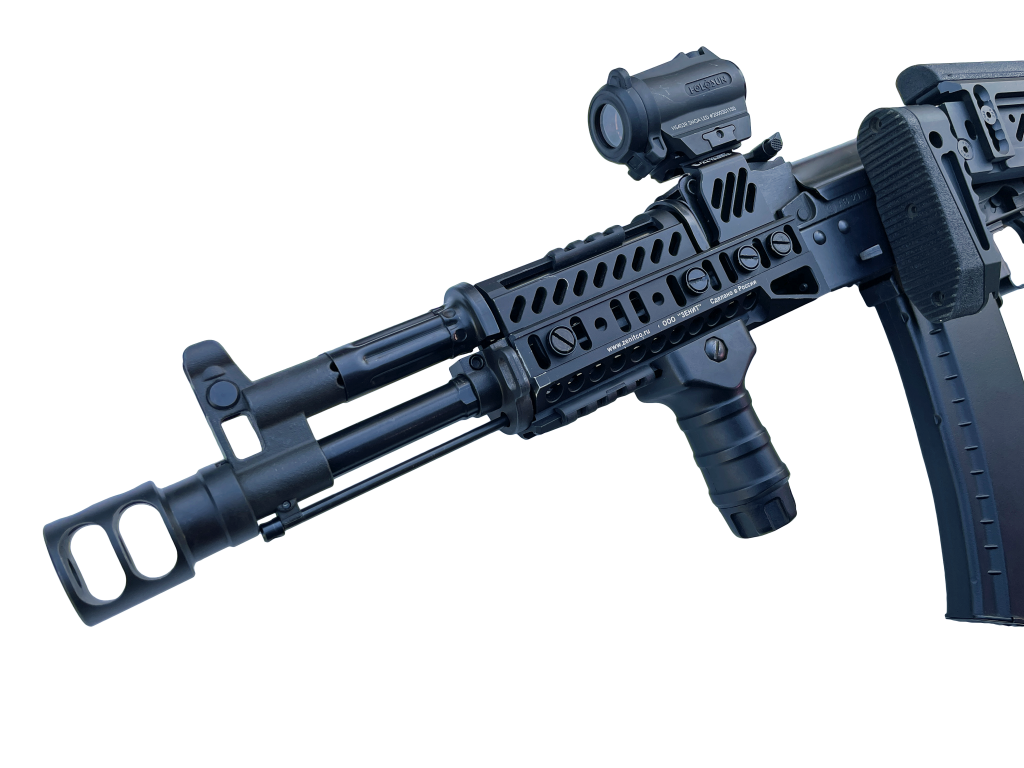
Off the front end is a replica of the 24mm DTK-2 muzzle brake by Zenimei. On the real rifle, this muzzle brake is extremely effective at reducing recoil to almost negligible levels. I’ve skewed a little ways from traditionalism by using a Tango Down stubby vertical foregrip instead of one of the usual Zenitco variants. This is just personal preference and for indexing familiarity. It also makes a nice barricade stop too.
Coming to the back of the rifle, I’m running the PTS US Palm AK Battlegrip. Again, this is just personal preference as that’s what I run on my real rifles. An LCT replica of the Zenitco PT-1 stock finishes off the furniture changes. The PT-1 is adjustable for length of pull, cheek riser height and even the position of the buttpad can be changed too. It still allows for being folded and locked in the folded position much like the original polymer stock did. Finishing it all off is a 2-point Blue Force Gear VCAS sling in FDE, which is my favored sling design.
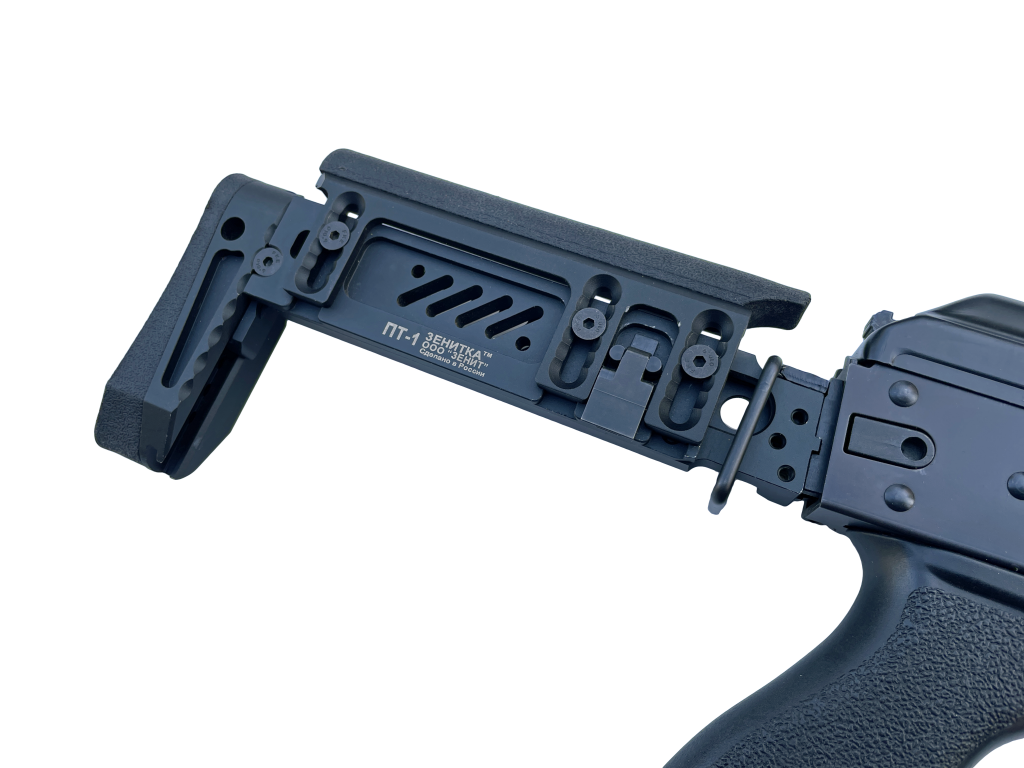
The finished build weighs in at 3.9kg (8.5 lbs) as configured and with magazine, pushing a crisp 25 RPS at 396 FPS and shoots absolute lasers with everything from .28g’s to heavyweight .36g’s.
So is it finished? Does it meet all the criteria for the “dream AK build”? I would like to think so, but know that this is a bit self-deceiving as nothing is truly ever finished in Airsoft. But for now, it’s hitting all the right boxes for me!
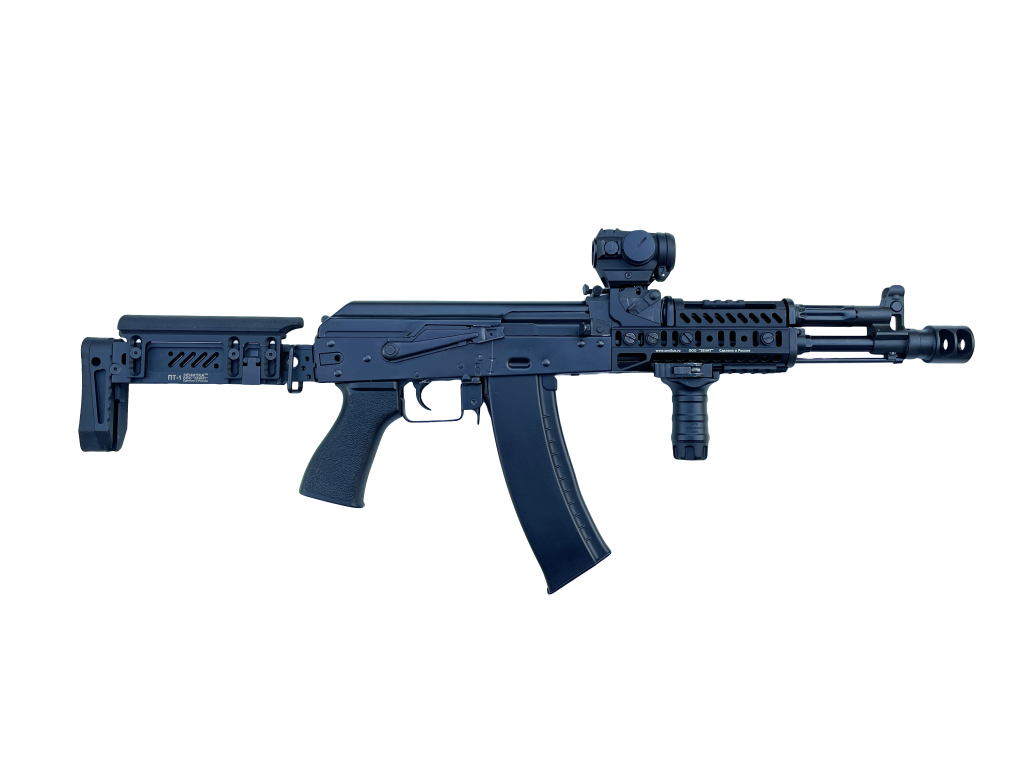
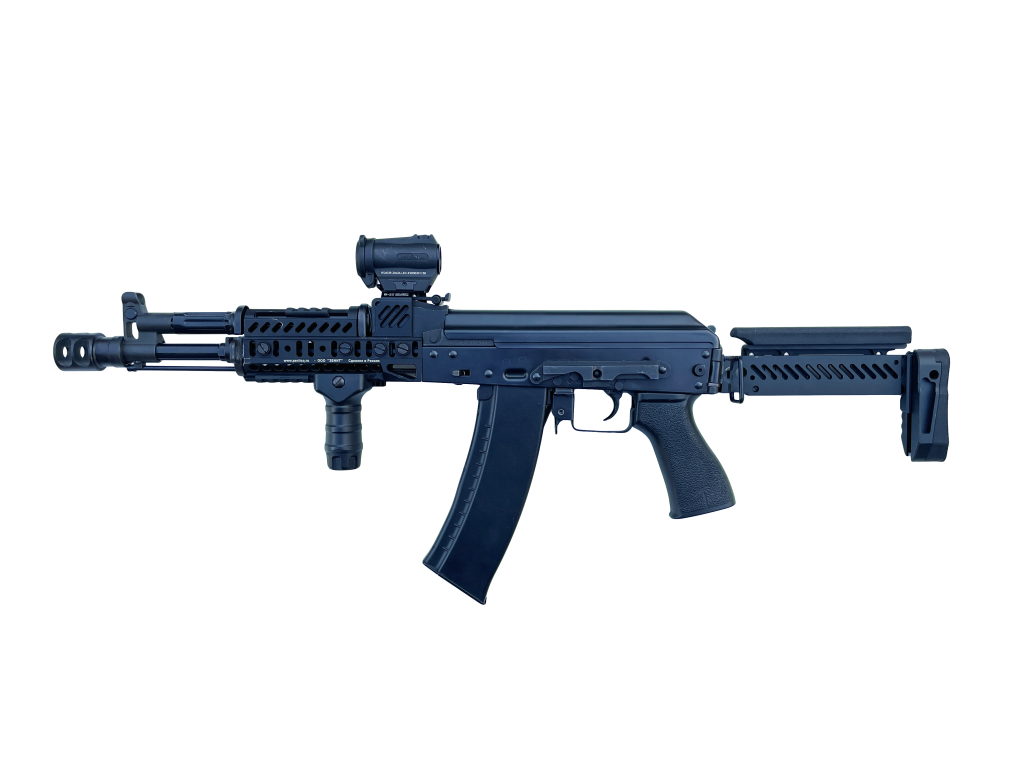
Specs
Externals
- LCT LCK104
- Zenimei DTK-2
- Raptors TWI B-10U / B-19N handguard set
- Zenitco B-22
- Holosun HS403R
- Tango Down stubby vertical foregrip
- PTS US Palm AK Battlegrip
- LCT Z-Series PT-1 Stock
Internals:
- Lambda One 6.01 SUS304 cold forged stainless steel barrel
- R-Hop w/M-Nub
- Modify Baton Ryusoku bucking
- LCT hop up chamber
- LCT air nozzle
- LCT tappet plate
- Guarder stainless steel double o-ring cylinder head
- LCT cylinder
- 70D AirPad
- Lonex POM piston head
- CYMA FMR piston
- Guarder SP120 spring
- Gate TITAN Advanced
- Modified LCT trigger
- SHS 13.65:1 gears, SS 3t
- LCT 9mm bearings
- LCT anti-reversal latch
- Warhead standard torque brushless motor
- LCT CNC motor cage
- Box cleaned and relubed with SuperLube